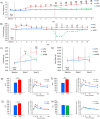Rapid and reversible impairment of episodic memory by a high-fat diet in mice
- PMID: 30097632
- PMCID: PMC6086894
- DOI: 10.1038/s41598-018-30265-4
Rapid and reversible impairment of episodic memory by a high-fat diet in mice
Abstract
Alzheimer's disease is a leading cause of morbidity and mortality with no cure and only limited treatment available. Obesity and type 2 diabetes are positively associated with the development of premature cognitive decline and Alzheimer's disease, linking diet with these conditions. Here we demonstrate that in mice episodic memory, together with spatial and contextual associative memory, is compromised after only one day of high-fat diet. However, object memory remains intact. This shows not only a more rapid effect than previously reported but also that more complex memories are at higher risk of being compromised by a high-fat diet. In addition, we show that these memory deficits are rapidly reversed by switching mice from a high-fat diet back to a low-fat diet. These findings have important implications for the contribution of nutrition to the development of cognitive decline and Alzheimer's disease.
Conflict of interest statement
The authors declare no competing interests.
Figures



References
Publication types
MeSH terms
Substances
Grants and funding
LinkOut - more resources
Full Text Sources
Other Literature Sources
Molecular Biology Databases

